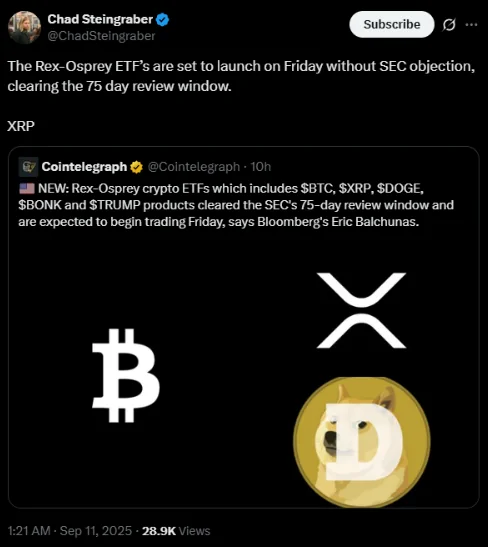Key Insights
- REX and Osprey cleared the SEC’s 75-day review, which has paved the way for five new crypto ETFs.
- The lineup includes Bitcoin, XRP, Dogecoin, Bonk and Trump token ETFs under the 1940 Act structure.
- While these ETFs advance, the SEC has delayed decisions on rival applications from major firms.
The REX-Osprey crypto ETFs are on track to launch this Friday, after clearing the US Securities and Exchange Commission’s 75-day review process. Bloomberg Intelligence analyst Eric Balchunas confirmed the funds are “post-effective”
This means that they are approved for listing unless the SEC objects at the last minute.
Why the 1940 Act Structure Matters
The difference between the 1940 Act and 1933 Act structures lies in how the funds operate.
1940 Act funds work as open-end investment companies. They can hold securities like futures contracts and derivatives. This makes them suitable for crypto ETFs that do not directly hold spot assets.
The 1933 Act funds are usually used for physically backed products like spot Bitcoin or gold ETFs. These products require more rigorous SEC review and tend to face longer delays.

The REX-Osprey ETFs use the 1940 Act model, which explains why their approval moved faster.
The Dogecoin ETF, for example, uses a Cayman Islands subsidiary and derivatives exposure, rather than direct holdings of DOGE. This approach provides crypto exposure while staying within regulatory boundaries.
SEC Delays on Rival Applications
While the REX-Osprey lineup moves forward, the SEC has pushed back several other crypto ETF applications.
The agency delayed decisions on Ether ETF proposals from Franklin Templeton, BlackRock, and Fidelity. These filings included staking features that require additional review.
Decisions on XRP and Solana ETFs have also been postponed.
Earlier this week, the SEC pushed back the deadlines for Bitwise’s Dogecoin ETF and Grayscale’s Hedera ETF to November 12. These moves show that the SEC is still cautious toward products that involve staking or spot exposure.

Recent guidance from the SEC clarified that proof-of-stake blockchains are not securities in themselves. The agency also stated that certain liquid staking activities fall outside securities laws.
Even so, ETF filings that include continue to stay under close examination.
Market Impact of the REX-Osprey ETFs
The REX-Osprey products represent the first group of multi-asset crypto ETFs to list in the United States under the 1940 Act framework. They offer access to Bitcoin, XRP, Dogecoin, Bonk, and the Trump token
By relying on derivatives instead of direct spot holdings, the funds were able to clear the SEC’s review more quickly. This approach has proven to be an effective pathway for sponsors who want to bring crypto ETFs to market without long delays.
Bloomberg ETF analyst James Seyffart noted that 92 crypto exchange-traded products are currently in the US pipeline.

The REX-Osprey launch shows that the competition is heating up among firms to secure regulatory approval and bring innovative products to investors.
Outlook for Crypto ETFs in the US
The REX-Osprey launch marks an important step in the growth of crypto ETFs within the country. Its use of the 1940 Act structure means that the sponsors have managed to bring products to market without the extended delays faced by previous spot ETFs.
The debut of these funds is bound to be closely watched by both market participants and regulators, especially as the industry continues to push for further approval of crypto investment vehicles.
At the same time, the SEC’s ongoing review of rival applications shows that the path is still uneven.
Proposals involving staking and spot exposure will continue to face more headwinds than their counterparts. For now, the REX-Osprey funds stand out as an early example of how sponsors can use exciting frameworks to launch crypto ETFs in the United States.

Soraya Alizadeh covers the burgeoning intersection of fintech and blockchain innovation. Known for her meticulous research and clear, engaging storytelling, she explores regulatory challenges and opportunities within Iran’s crypto market, aiming to inform both industry insiders and newcomers.





